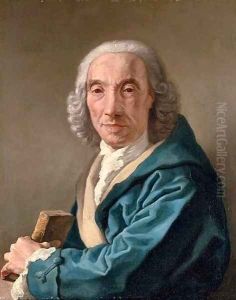Jacques Aved Douai Paintings
Jacques-André-Joseph Aved, also known as Aved Douai, was a French painter and portraitist during the Rococo period, born in 1702 in Douai, France. He is known for his masterful portraits of the French aristocracy and notable figures of his time. Aved's work was characterized by its elegant representation of his subjects, often capturing them with a sense of realism and psychological depth.
Aved received his initial artistic training from a local painter in Douai before moving to Paris to further his studies. He became a student of the painter Hyacinthe Rigaud, who was a prominent portraitist during the reign of Louis XIV. Under Rigaud's guidance, Aved honed his skills and developed a keen eye for detail and an ability to portray the character and status of his sitters.
During his career, Aved became a member of the Royal Academy of Painting and Sculpture in 1728, which was a significant acknowledgment of his talent and established his place among the era's leading artists. He exhibited his works at the Salon, the official art exhibition of the Académie des Beaux-Arts in Paris, and received commissions from members of the French elite, including the royal family and foreign dignitaries.
Aved's portraits are recognized for their nuanced brushwork and the subtle gradation of tones. He was adept at capturing the textures of fabrics, the sparkle of jewelry, and the intricate details of lace and embroidery, which added to the luxurious feel of his portraits. Beyond his skill in rendering the physical attributes of his subjects, Aved was also celebrated for his ability to convey their personalities and social standing through his art.
Apart from portraiture, Aved also engaged in historical and religious subjects, although these works did not gain the same level of acclaim as his portraits. Despite the changing tastes in art, particularly with the advent of Neoclassicism, Aved maintained a successful career throughout his life.
Jacques-André-Joseph Aved passed away in 1766 in Paris. His works continue to be appreciated for their artistry and as a reflection of the Rococo period's social and cultural milieu. Aved left behind a legacy that provides valuable insight into the French aristocracy's life and the refined elegance of 18th-century portrait painting.
